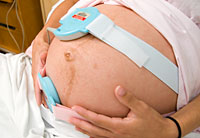Holistic Pregnancy & Childbirth

What Factors Influence the Progression of Childbirth?
Your body is perfectly designed to promote a healthy pregnancy and childbirth. For the majority of healthy pregnant people, childbirth progresses spontaneously without complications. However, there are steps you can take to promote this normal progression, and there are factors that can interfere with it.
What are the physical factors?
Many physical factors can promote the progression of labor.
Position of the baby
The position of your baby might play a role. Most babies navigate best through the pelvis if they are head down, with their face toward your spine. This is called an anterior position. During the last weeks of pregnancy, try to promote this positioning of your baby.
- Avoid lying on your back.
- When relaxing, choose forward leaning positions such as sitting on a physical therapy ball with your legs apart.
- When resting or sleeping, lay on your side as far to your stomach as you comfortably can.
 Your position
Your position
As contractions begin, choose positions of comfort. Freedom of movement and frequent position changes can help the baby choose optimal positions for birth. Upright positions allow you to use gravity to promote the downward movement of the baby.
You might find it very difficult to move during a contraction. That's okay - just relax as much as possible during the contraction, breathe slowly and deeply, and move when it is over. You might also find that changing to a new position makes the contraction more intense or painful. However, try to avoid switching again too soon - try several contractions in the new position, readjusting and regrouping - before deciding to abandon it. Alternate upright positions with positions of rest, such as sitting in a rocking chair or side-lying in bed.
How can emotions impact labor?
Your emotional wellbeing is very important during labor. Do what you can during pregnancy to address fears and concerns so you can enter labor with confidence in yourself, your partner, your other birth attendants, and your midwife or doctor.
 You can also use guided relaxation or meditation at any time during labor to help you build images of safety and strength, or to identify fears that might need to be addressed.
You can also use guided relaxation or meditation at any time during labor to help you build images of safety and strength, or to identify fears that might need to be addressed.
People in labor are often advised to let go and release control of labor to their bodies' own innate ability. In order to do this, you will need to feel safe with the environment and with your chosen care providers and support people. Because labor is a time when many birthing people feel vulnerable, you should ask for understanding, support, and respect from those around you to help enhance your feelings of safety and strength.
What helps the natural progression of labor
Support
The active participation of your partner, doula, labor nurse, midwife, or doctor is one way to promote the natural progression of labor. Research shows that the presence of a doula or other supportive person is associated with many positive benefits during childbirth, including shorter labors, less use of pain medication or epidurals, fewer cesarean sections, and successful chestfeeding. Your midwife, doctor, or labor nurse may spend considerable time supporting you, but they might also have responsibilities for other laboring people as well. A doula, on the other hand, is likely to spend much of your labor with you.
Touch
Human touch can also help labor progress. This touch can take many forms: back and hip counter-pressure to help alleviate pain, massage to promote relaxation, acupressure to alleviate pain or promote effective contractions, or energy work such as Therapeutic Touch or Reiki to promote relaxation and pain relief.
It can even be as simple as holding someone's hand for support.
Water therapy
Many childbirth professionals promote the use of water therapy-immersion in a warm tub or warm shower-to cope with and shorten active labor. In general, it is best to wait until labor is well established before entering the water or your contractions might become less strong or less frequent. (However this might not necessarily be a disadvantage, if you need a break from a long labor to rest and regroup.)
Lighting
One of the pioneers in the natural childbirth movement, obstetrician Robert Bradley, compared the medicated and difficult childbirths of people in brightly lit, tiled delivery rooms with the relatively easy births of animals that chose dark, comfortable places of safety. Thus, his initial recommendation to promote the natural progress of labor was to choose a dark, quiet environment.
Sound and scent
You might want to bring music that you enjoy, find meaningful to you, or feel simply promotes feelings of relaxation.
You can also consider aromatherapy, which can contribute to feelings of wellbeing and thus influence your course of labor. Many birth professionals recommend the use of lavender during labor. You can try an infuser or make a small sachet. Check ahead of time for any hospital policies on "scent-free environments."
It should come as no surprise that the opposites of some of the promoting factors we discussed above can interfere with labor progress.

Spending most of your time in bed, especially lying on your back, or sitting up at a small angle, interferes with labor progress:
- Gravity works against you, and the baby might be more likely to settle into a posterior position.
- Pain might increase, especially back pain.
- Blood circulation to your uterus decreases, which could lead to less effective contractions.
- Blood circulation to your baby also decreases.
Electronic fetal monitoring frequently confines women to bed. This prevents birthing people from using gravity to encourage movement. Note that there is no evidence that continuous monitoring provides a safer childbirth experience than intermittent monitoring, and its use has been associated with increased cesarean sections and other interventions.
Even if you require continuous fetal monitoring, you can use almost any position-with some adaptation. If available, you can use telemetry monitoring that transmits data wirelessly to a central monitoring station. If telemetry monitoring is not available, don't just lie down-you can still stand at the side of the monitor, walk a very short distance, sit on a birthing ball or rocking chair, labor on your hands and knees, or use a variety of other positions.
Fear, embarrassment, or a lack of support, can also interfere with labor progress. Fear and anxiety release hormones, such as adrenalin, which can slow labor contractions. If you had a particularly difficult time at a certain point in a previous labor, you might find yourself approaching that same point with fear. Most healthcare providers can provide many stories of labors that seemed to have stopped progressing, but progressed well after talking about emotional concerns, expressing fears aloud, and perhaps clearing the air with some tears.
Sometimes, those you have invited to provide support might instead create tension or have difficulty dealing with the demands of labor. If this happens, although it might be difficult, you might consider asking them to leave for awhile. If you feel more emotionally centered in their absence, you can ask them to return after the baby has been born. If you find that you miss their support, you can ask them to rejoin you, after a brief discussion on how they can better help.
People who have experienced sexual abuse, whether in the recent or far-distant past, might have unique fears about childbirth. Memories of pain may resurface during labor. If you have experienced abuse in the past, we encourage you to bring this up with your midwife or doctor, so that they are aware of your experiences. If you have not had counseling or therapy and would like to, ask for a referral. Your birth partner(s) might also be able to help you more effectively if you talk with them about this. Ask your birth partner(s) to remind you that you are giving birth to your baby and that you are safe in the birth center (or wherever you are). They can remind you that you are feeling contractions that are opening the cervix, or pressure from the baby's head stretching your tissues. They should not use expressions such as "just give in," or "don't fight it," as these might be phrases that were used by your abuser.
While individual factors might not have a large impact on the progress of labor, they could lead to what is known as a cascade of interventions, which could have a cumulative effect on the progression of labor.
 For example, inducing labor should theoretically promote labor progress. However, most induction methods require bed rest and monitoring. Being restricted might increase pain levels and the chance of the baby settling into an unfavorable position. Increased pain could result in early use of pain medication or epidural anesthesia, which further limit movement. Epidural anesthesia could make pushing efforts less effective and increase the likelihood of a cesarean section, vacuum, or forceps delivery.
For example, inducing labor should theoretically promote labor progress. However, most induction methods require bed rest and monitoring. Being restricted might increase pain levels and the chance of the baby settling into an unfavorable position. Increased pain could result in early use of pain medication or epidural anesthesia, which further limit movement. Epidural anesthesia could make pushing efforts less effective and increase the likelihood of a cesarean section, vacuum, or forceps delivery.
- 1 of 7
- 2 of 7
- 3 of 7
- 4 of 7
- 5 of 7
- 6 of 7
- 7 of 7
What effects can pain medication and epidurals have on the progression of childbirth?
 Pain medication and regional anesthetics (such as epidural, intrathecal, or spinal anesthesia) bear special mention. Most midwives and physicians agree that the use of pain medication or regional anesthesia during early labor can slow labor progress. A common midwifery text by Varney describes this very well, cautioning midwives about using IV pain medication too early in labor: "although you have made the woman extremely comfortable, you have lengthened the total labor by several hours (for which she would probably not thank you if she knew)."
Pain medication and regional anesthetics (such as epidural, intrathecal, or spinal anesthesia) bear special mention. Most midwives and physicians agree that the use of pain medication or regional anesthesia during early labor can slow labor progress. A common midwifery text by Varney describes this very well, cautioning midwives about using IV pain medication too early in labor: "although you have made the woman extremely comfortable, you have lengthened the total labor by several hours (for which she would probably not thank you if she knew)."
Risks of epidurals
Most researchers have concluded that epidurals or other regional anesthesia may be associated with longer labors, longer pushing, increased risk of vacuum, forceps, and cesarean sections, as well as increased risk of other complications, such as low blood pressure (which might adversely affect the baby), fever, headache, and nerve damage. (It should be noted however that a newer research study challenges the association with longer labor lengths and increased cesarean sections.)
Situations where they may be beneficial
However, in some instances, pain medication or epidural anesthesia might help to promote labor progress.
- Medication might help birthing people who are very fearful and who have not been able to alleviate this anxiety with emotional support.
- Anesthesia might help the pelvic muscles relax when a birthing person cannot relax using breathing, relaxation, and supportive techniques.
- Epidurals might help birthing people with an uncontrollable urge to push against an only partially dilated or swollen cervix to stop pushing, allowing the swelling of the cervix to subside and dilation to continue.
What you should ask about medications
You should make a decision to use medications or interventions during labor carefully and take plenty of time to ask questions about this during your prenatal exams. Ask your midwife or physician for input if you are considering these choices. Informed consent for medications, or for other proposed labor interventions, means that you know the following:
- The name of the drug, procedure, or other intervention.
- The reason the drug, procedure, or intervention is being proposed (the benefits).
- The potential risks of the proposed therapy.
- What would happen if you did not use the proposed therapy, or if you waited.
- What alternatives exist to the proposed therapy.
Unless there is an emergency, it is always appropriate to ask questions, and to ask to be given time to talk privately with your partner as you make a decision. We've mentioned this before, but it is worth saying again: try not to make a decision about pain medication in the middle of a contraction!
A very brief description of some medical forms of pain relief for labor and their risks and benefits can be found at SutterHealth.org.

Birthing Positions
There are several birthing position options to consider. View these photos and read their descriptions to help prepare for childbirth.

Questions to ask your birthplace
Bring these questions with you as you consider potential birthing centers or hospitals.
Questions for your Birthplace
Here are some questions to consider as you tour or talk with staff at potential birthplaces:
Support for holistic childbirth
- Do the nurses at the birthplace provide labor support? Have they attended doula workshops?
- Are the nurses interested in holistic childbirth?
- If my nurse is not skilled at providing labor support, can I switch nurses?
- Are any complementary therapies available, for example massage or other bodywork?
- Are doulas available at the hospital?
- May I bring my own doula?
Facility policies
- Are there any policies about the number of family or friends who can attend my birth?
- What procedures take place upon admission to the birthplace?
- Are there any procedures that all laboring people must adhere to, such as having an IV in place? What would happen if I declined such a procedure?
- Are there any policies or recommendations about eating or drinking? Do these policies change if I have an epidural?
- Does the facility offer vaginal birth after a cesarean section (VBAC)?
- How is my progress monitored during labor?
- How is my baby's wellbeing monitored during labor?
- If applicable: English is not my first language. How rapidly can I get an interpreter? (Even if you are proficient in English, might be easier for you to have an interpreter while coping with labor, especially when medical terminology is used.)
Facility statistics
- What is the epidural rate at your facility?
- What is the cesarean section rate?
- How quickly can a cesarean section be done in an emergency?
- What percentage of people at this birthplace have continuous monitoring during labor?
Available childbirth aids
- Is telemetry monitoring available? The last time you wanted to use it, was it working?
- Do you have birthing balls? A birthing stool? Birthing bars?
- Are there bathtubs? What limitations do you have about who can labor in the water?
- Do you offer waterbirth? What limitations do you have about who can give birth in the water?
Postpartum and babycare practices
- Is your birth center a "Baby-Friendly" facility? (*See note.)
- Do most parents at your facility keep their babies with them or send them to the nursery at night?
- Does the birthplace have lactation consultants on staff?
After you have asked the above questions, you should be able to ask yourself the following questions:
- Will I feel comfortable giving birth here?
- Will I feel supported in my plans for birth, or does the staff give the impression that my plan would be inconvenient or unrealistic?
*Baby-Friendly Facilities:
The World Health Organization and UNICEF have joined to sponsor the worldwide Baby-Friendly Hospital Initiative (BFHI) to promote breastfeeding. Hospitals and birth centers may make application with the BFHI, certifying that they meet ten standards outlined by the Initiative that have been shown to be effective in increasing successful breastfeeding.

Review these questions with your midwife or doctor
Review these questions with your midwife or doctor.
Questions for your Midwife or Doctor
As you talk with a potential midwife or doctor, here are some things to consider asking.
Credentials and Privileges
- Is the provider board-certified, and if so by what organization?
- Where does the provider attend births (what hospitals or other facilities)?
- If the provider is a home-birth provider, and what systems are in place for consultation or transfer if that becomes necessary?
Childbirth Practices
- Does the provider have preferences regarding eating and drinking in labor?
- How does the provider monitor your progress during labor?
- How does the provider monitor your baby's well-being during labor?
- Does the provider offer any complementary therapies? If so, what are they, and are there any limitations on their use?
- Does the provider support waterbirth? If so, are there limitations on who may give birth in the water?
- Does the provider have any restrictions on positions that you can give birth in?
- Does the provider typically take the foot of the bed off for birth, or leave it in place?
- What medical methods of pain relief does this provider typically use?
- If your provider practices in a group, might you see a different provider at birth? If so, how are differences in philosophy between group members dealt with?
Provider Statistics
- How much time does the provider schedule for each prenatal appointment?
- What is the provider's induction rate? Why are women typically induced?
- What is the provider's epidural rate?
- What is the provider's cesarean section rate?
- What percentage of the provider's patients has an episiotomy?
- Does the provider practice within a group, and, if so, how large is the practice?
- If the provider practices within a group, what are the rates of the above interventions for the group?
- What percentage of the provider's patients give birth without using any medication or epidural for pain?
Hopefully, the answers to the above questions will let you ask these questions of yourself:
- Did the provider welcome your questions?
- What does this provider's attitude toward holistic childbirth seem to be?
- Did the provider appear to trust the birth process?
- Did you feel patronized or put down by any of the answers?
Learn more about integrative therapies
If you would like to learn more about how integrative therapies, such as aromatherapy or guided imagery might help address some of the discomfort or stress of childbirth, you may want to check out these courses on the Coursera platform. Heath professionals will find a wealth of information on how to provide patient-centered care in our Integrative Health and Medicine and Integrative Nursing Specialization.
American College of Obstetricians and Gynecologists (ACOG). (2005). Intrapartum fetal heart rate monitoring. ACOG practice bulletin No. 70. 2006 Compendium of Selected Publications. Washington, D.C.: ACOG.
Enkin, M., Keirse, M., Neilson, J., Crowther, C., Duley, L., Hodnett, El, & Hofmeyr, J. (2000). A Guide to Effective Care in Pregnancy and Childbirth, 3rd ed. New York: Oxford University Press. The full text of this book is available online.
Simkin, P., and Ancheta, R. (2005). The labor progress handbook, 2nd ed. Oxford: Blackwell Publishing.
Thorp, J.A., Hu, D.H., Albin, R.M, et al. (1993). The effect of intrapartum epidural analgesia on nulliparous labor: a randomized, controlled, prospective trial. American Journal of Obstetrics & Gynecology, 169(4), p. 851-858.
Varney, H., Kriebs, J.M., & Gregor, C.L. (2004). Varney's midwifery, 4th ed. Sudbury, MA: Jones and Bartlett.
Wong, C.A., Scavone, B.M., Peaceman, A.M. et al. (2005). The risk of cesarean delivery with neuraxial analgesia given early versus late in labor. New England Journal of Medicine, 352, p. 655-665.
Additional Reading
The Thinking Woman's Guide to a Better Birth. 1999. Henci Goer. Perigee Trade.


